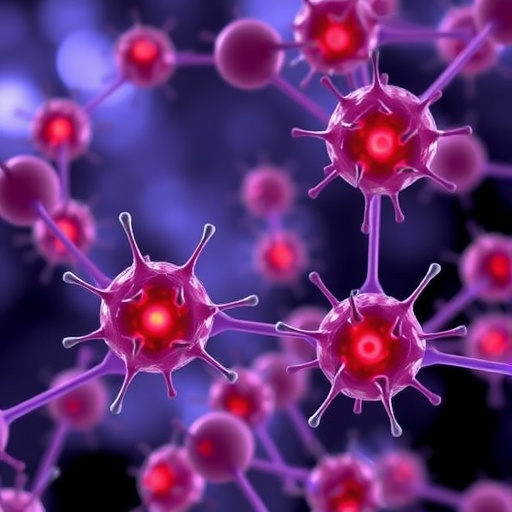In a groundbreaking study, researchers Xu, Zhang, and Yu explore the cutting-edge realm of nano-therapeutics aimed at addressing a prevailing health concern: atherosclerosis. This condition, primarily characterized by the buildup of plaque within arteries, leads to significant cardiovascular risk. The authors have meticulously examined how leveraging the macrophage-based microenvironment can revolutionize treatment approaches, marking a potential shift in therapeutic strategies for managing this debilitating disease. This article unravels the intricate dynamics between nano-therapeutics and cellular interactions that contribute to the pathogenesis of atherosclerosis, and in doing so, it sketches a promising horizon for cardiovascular medicine.
The burden of atherosclerosis on global health is profound, with millions succumbing to complications related to heart disease and stroke each year. Traditional interventions often focus on lifestyle changes and pharmaceutical therapies, yet these approaches are frequently met with limited success. Consequently, the quest for more effective treatment modalities has ushered researchers into the innovative domain of nanomedicine. Nano-therapeutics are engineered to operate on an exceptionally small scale, permitting precision in targeting biological pathways associated with disease progression while minimizing collateral damage to healthy tissues.
At the heart of this study lies the macrophage’s dual role as both a facilitator and aggressor in atherosclerosis. Macrophages are immune cells that adapt to their environment, which in the case of atherosclerosis, can lead to either the promotion of inflammation or the resolution of plaque. By fine-tuning the behaviors of these cells through nano-therapeutics, the researchers have envisioned a novel paradigm in treatment strategies. They propose harnessing nanoparticles that can either inhibit pro-inflammatory macrophage activity or promote the healing functions of alternative macrophage phenotypes.
The authors delve into the types of nanoparticles being investigated, including liposomes, dendrimers, and polymeric nanoparticles, each offering unique properties suited for specific therapeutic goals. Liposomes, for instance, can encapsulate drugs and enhance their bioavailability, while dendrimers are designed for targeted delivery. The multifunctionality of these nanoparticles can be pivotal in altering the course of treatment for atherosclerosis, and thus, their design remains a focal point for ongoing studies in this paper.
A significant portion of the research highlights the importance of the macrophage microenvironment in shaping the efficacy of nano-therapeutics. The microenvironment encompasses a complex interplay of cellular signals, extracellular matrix components, and biochemical factors. The authors emphasize that understanding these intricacies is essential for developing effective nano-mediated strategies. By manipulating factors such as cytokine release and metabolic pathways, researchers can create a conducive environment for macrophage reprogramming, potentially leading to improved patient outcomes.
Moreover, the paper discusses the role of biocompatibility and biodegradability in the design of nanoparticles. Safety remains a critical concern when introducing foreign materials into the human body, particularly in the context of cardiovascular applications. The selected materials must not elicit significant adverse reactions, and their eventual breakdown should present no harm to cellular architecture. The authors outline methodologies for assessing the biocompatibility of these nanoparticles and the metrics for evaluating their efficacy in in vitro and in vivo studies.
In an exciting development, the research team also explores the potential for personalized medicine through nano-therapeutics. Individual genetic profiles and metabolic states can influence the pathogenic role of macrophages in atherosclerosis. By employing a patient-specific approach, it may be possible to tailor nano-therapeutic interventions that are most likely to succeed, boosting the effectiveness of treatment while reducing the risk of side effects. The integration of genomic data with therapeutic design is highlighted as a frontier in medical innovation.
As the study progresses, Xu, Zhang, and Yu present compelling evidence from preclinical and ongoing clinical trials that underscore the therapeutic promise of nano-therapeutics in managing atherosclerosis. Preliminary findings suggest significant reductions in plaque size and improvements in vascular function among subjects treated with the engineered nanoparticles. Such outcomes could mark a pivotal advancement in the battle against cardiovascular diseases, which historically have posed enormous challenges to conventional therapies.
Despite these promising developments, the authors do not shy away from outlining the daunting hurdles that remain. Regulatory pathways for nano-drug approval, long-term stability of nanoparticle formulations, and the complexities of scaling production are areas that necessitate further exploration. Additionally, the variability in patient responses due to comorbidities poses challenges that will require sophisticated analytical techniques to address comprehensively.
The discourse surrounding the socio-economic implications of introducing nano-therapeutics into clinical practice is also addressed. While the potential benefits are significant, the costs associated with developing, producing, and implementing these advanced therapies could be substantial. It is crucial to establish systems that ensure equitable access to these innovations once they reach the market, especially in populations that bear a disproportionate burden of cardiovascular diseases.
In conclusion, the work of Xu, Zhang, and Yu sets the stage for a transformative era in the management of atherosclerosis through the strategic use of nano-therapeutics. The intersection of nanotechnology and immunology presents a compelling frontier for therapeutic development that holds the promise of unparalleled precision in treatment. As research in this field continues to burgeon, the possibility of significantly reducing the prevalence of atherosclerosis and its complications becomes an increasingly attainable goal. The future landscape of cardiovascular medicine may soon be defined by the innovative application of nano-therapeutics, changing the way we approach one of the leading causes of morbidity and mortality worldwide.
Subject of Research: Nano-therapeutics targeting macrophage-based microenvironment in atherosclerosis treatment.
Article Title: Nano-therapeutics targeting the macrophage-based microenvironment in the treatment of atherosclerosis.
Article References:
Xu, Y., Zhang, Y. & Yu, W. Nano-therapeutics targeting the macrophage-based microenvironment in the treatment of atherosclerosis.
J Transl Med 23, 1171 (2025). https://doi.org/10.1186/s12967-025-07222-7
Image Credits: AI Generated
DOI: 10.1186/s12967-025-07222-7
Keywords: Atherosclerosis, nano-therapeutics, macrophages, biocompatibility, personalized medicine, cardiovascular disease.
Tags: cardiovascular risk factors and nanotherapycellular interactions in atherosclerosischallenges in traditional atherosclerosis therapiesemerging strategies for managing atherosclerosisimmune response in atherosclerosisinnovative treatments for plaque buildupmacrophage targeting in cardiovascular diseasenanomedicine advancements in cardiovascular healthnanotherapeutics for atherosclerosisnew approaches to heart disease treatmentprecision medicine in atherosclerosisrole of macrophages in heart disease





